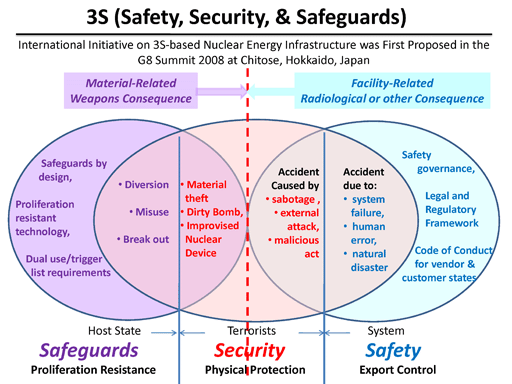International Forum on Peaceful Use of Nuclear Energy and Nuclear Security
- Taking the lessons learned from the Fukushima Daiichi Nuclear Power Plant Accident to the 2012 Seoul Nuclear Security Summit -
Opening Remarks
Dr. Atsuyuki SUZUKI, JAEA President
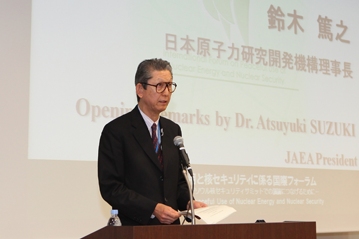
- Regarding the accident at Fukushima Daiichi nuclear power plant (the Fukushima nuclear accident) caused by the March 11 earthquake off the coast of Tohoku and the tsunami that followed, the nuclear reactors are currently under control on their way to cold shutdown, but several months of measures and responses will be necessary before complete stability is achieved. I am grateful for the aid and support that various communities around the world have provided to the victims and evacuees.
- We currently face two pressing issues regarding the accident. The first is the effort to complete stabilization of the nuclear reactors and their long-term decommissioning. The second is off-site contamination and environmental remediation. Both on-site and off-site responses are required, and the JAEA will utilize all its ability to respond to the extent possible.
- In light of the Fukushima nuclear accident, awareness of the similarities of securing nuclear safety and security has increased. Whatever the cause or intention of a nuclear accident might be, the accident has the potential to cause damage across national borders. In terms of nuclear security, it is important to strengthen measures to prevent outside attacks on nuclear facilities as well as internal threats. The 2010 Washington Nuclear Security Summit called for thorough management of vulnerable nuclear material within four years. In addition to the responses of various countries to this call, the 2012 Seoul Nuclear Security Summit will focus on the knowledge that has been obtained from the Fukushima nuclear accident.
- With above situation in mind, this forum has invited experts from relevant international and domestic organizations. Through keynote addresses, special lectures, and panel discussions, the forum will discuss effective strategies and measures for enhancing nuclear security. The results of the forum will be reported at the 2012 Seoul Nuclear Security Summit.
- Japan's post–Fukushima nuclear accident nuclear energy policy is currently being debated. It is too soon to say much, but because the Japanese government intends to contribute to both global nuclear safety and security, I hope that this forum's conclusions will contribute to deciding Japan's future nuclear power policy.
Keynote Speeches
Nuclear security and safety issues revealed by the Fukushima Nuclear Accident
Mr. Yoshinori SUEMATSU, Special Advisor to the Prime Minister
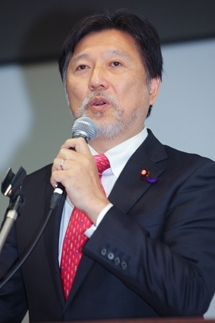
[Introduction]
- I was head of the Miyagi Response Office and am currently involved with the Fukushima nuclear accident as the person in charge of reconstruction in response to the Great East Japan Earthquake. However, since I am not directly in charge of recovery from the accident, what I say here today will be my personal opinion, not that of the Government.
[The Fukushima nuclear accident]
- As of yesterday, the nuclear reactors reached cold shutdown. I hope this progress will continue. After the middle of this month, it is to be announced that Step 2 (cold shutdown) has been reached. The next steps will concern the issues of the return of evacuees to the hazard zone and their compensation.
[Nuclear safety and security]
- Nuclear safety in Japan has been revisited since the Great East Japan Earthquake, but up to now there has been less interest in nuclear security. Initiatives on nuclear security will be important in the future. The Fukushima nuclear accident in particular spotlighted the problem of loss of power, so we should also study how to prevent intentional loss of power.
- When events related to nuclear accidents or nuclear security occur, the cost of recovery is high. Maximum efforts to prevent accidents are necessary. In Japan, a new, independent nuclear regulatory agency in charge of nuclear safety and security will be established. It will coordinate the nuclear safety and security activities of the Japan ministries of Economy, Trade and Industry (METI), Education, Culture, Sports, Science and Technology (MEXT), and Defense (MOD), as well as the Coast Guard, JAEA and other national and international research institutes and organizations.
[Problems of structural and design vulnerability]
- In addition to accidents caused by natural disasters such as earthquakes, tsunamis, and abnormal weather, and those caused by errors, nuclear facilities must protect against human attacks. Therefore, study of the protection of secrets, measures to prevent or delay attackers from reaching their goals, response to cyber-terrorism, and design issues, such as the locations of spent fuel pools and backup power sources, are necessary. In addition, diplomatic initiatives are required to prevent military action against nuclear facilities by other countries.
[Risk communication]
- In risk communication, it is important to convey appropriate information. In mid-October, when the IAEA mission to assess the appropriateness of decontamination activities came to Japan, its press conference noted that not only did Japan's decontamination activities meet international standards, they surpassed them. I had hoped that this would have been reported to the people of Fukushima, but in fact, only one or two newspapers covered the story. In part, government efforts to reach out to the mass media were insufficient. I reaffirm that good relations with the media outlets should be constantly nurtured.
[Strengthening international networks]
- International sharing of information and best practices on nuclear safety and security is important. I hope the discussions at this forum will serve as a springboard for the 2012 Nuclear Security Summit in Seoul in April and for the international conference on nuclear safety that is to be jointly sponsored by Japan and the IAEA during the second half of 2012.
Evaluation of and lessons learned from the Fukushima Nuclear Accident
Mr. Denis FLORY, Deputy Director General and Head of Department of Nuclear Safety and Security, International Atomic Energy Agency (IAEA)
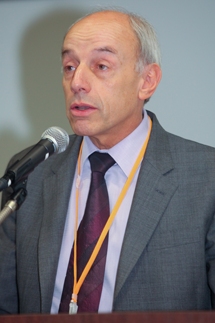
[Introduction]
- Incident reporting and experience feedback processes are an essential part of a developed nuclear safety infrastructure. The Three Mile Island accident led to improvements in the man-machine interface. The Chernobyl accident lessons improved safety culture, infrastructure, and protection of human health. After September 11, nations reviewed their nuclear facilities for terrorism and sabotage vulnerabilities and amended the Convention on the Physical Protection of Nuclear Material. Moreover, the IAEA works under two conventions established since the Chernobyl accident: the Convention on Early Notification of a Nuclear Accident and the Convention on Assistance in the Case of a Nuclear Accident or Radiological Emergency.
- As with previous accidents, we must apply the lessons learned from the recent Fukushima nuclear accident.
[Lessons from the Fukushima nuclear accident]
- The Fukushima nuclear accident reconfirmed that nuclear disasters do not have borders.
- At the request of the IAEA Director General, the International Nuclear Safety Group (INSAG) issued recommendations on future action regarding the Fukushima nuclear accident. INSAG identified nine potential vulnerabilities: regulatory structure, chain of command, extreme events, severe accidents, loss of power, loss of cooling, accumulation of explosive gases, spent fuel storage pools, and emergency situation management.
[The IAEA Action Plan on Nuclear Safety]
- In response to the Declaration by the IAEA Ministerial Conference on Nuclear Safety in Vienna in June 2011, an IAEA action plan on nuclear safety was approved by the IAEA Board of Governors and adopted by the General Conference. The action plan consists of 12 items: a) safety assessments in light of the accident at TEPCO's Fukushima Daiichi Nuclear Power Station, b) IAEA peer reviews, c) emergency preparedness and response, d) national regulatory bodies, e) operating organizations, f) IAEA Safety Standards, g) international legal framework, h) Member States planning to embark on a nuclear power programme, i) capacity building, j) protection of people and the environment from radiation, k) communication and information dissemination, and l) research and development.
- The international legal framework: Strengthening the legal framework for safety measures was raised during the fifth review meeting of the Convention on Nuclear Safety (CNS) held in April 2011. The parties to the Convention agreed to hold an extraordinary meeting in August 2012. Regarding the necessity of amending the CNS, I would advocate a two-track approach that includes launching a carefully planned amendment process, supplemented by a variety of mechanisms and non-legally binding tools available to the international community. This is the right way forward to respond to the need for urgent actions to strengthen nuclear safety, without foregoing the longer-term process to gain more potent tools of a strengthened international legal regime. In addition, the necessity of ensuring the independence of national regulatory bodies and Japan's nonparticipation in international treaties on nuclear power liability systems were noted.
- IAEA safety standards: Since the Fukushima nuclear accident, many Member States have carried out comprehensive testing (so-called stress tests) to assess nuclear power plant vulnerabilities. However, harmonization of these assessments among countries is necessary. Within the IAEA Secretariat, we have developed methodology for the evaluation of nuclear power plant safety margins. A review of IAEA safety standards related to the accident is underway. As indicated in the report of the IAEA mission, however, even the best standards are useless if they are not properly applied.
- IAEA peer review: Peer reviews evaluate the effects of regulations, operational and design safety, and emergency preparedness and response. They are at the heart of the IAEA action plan to strengthen safety. Member States are encouraged to voluntarily host peer review missions.
- Emergency preparedness and response: On matters of emergency preparedness and response, the IAEA follows the Convention on Early Notification of a Nuclear Accident and the Convention on Assistance in the Case of a Nuclear Accident or Radiological Emergency, which were adopted after the Chernobyl nuclear accident. In order to meet its responsibilities under these conventions, IAEA established the Incident and Emergency Center (IEC) inside the Department of Nuclear Safety and Security. Information is exchanged with Member States through the Response and Assistance Network (RANET).
- Communication and information dissemination: Unlike the case with the Chernobyl nuclear accident, the status of the Fukushima accident was quickly transmitted. On the other hand, a typical communication problem arose when the International Nuclear Event Scale (INES) was cited, and Japan initially assessed the accident at level 5 ("accident with wider consequence") before revising it to level 7 ("major accident"). Some experts from other countries agreed with that assessment, while others argued it should be classified as level 6. This caused confusion among the public. The IAEA has launched a review of the implementation of the INES scale in order to avoid such repetition in the future.
- Transparency and the action plan: In order for Member States to be able to use the results of peer reviews more systematically, these reports should be published with the widest possible transparency. It is the necessary first step toward rebuilding trust between governments and the public.
- Nuclear safety and security: A nuclear accident can result from acts of terrorism or other malicious and intentional acts. The Fukushima nuclear accident pointed out the necessity of improving the protection of nuclear facilities against such acts. Although transparency in nuclear security is a difficult issue, nuclear security has not been overlooked. The IAEA is actively addressing the issue as one of the lessons learned from the Fukushima nuclear accident.
[Conclusion]
- The IAEA Member States recognize that resolution of the Fukushima nuclear accident will be a long-term process, but most actors involved in nuclear power have been acting promptly based on the lessons of the accident. The IAEA's action plan will be useful guidance. A nuclear safety action team was created inside the IAEA to oversee implementation of the action plan and to ensure its proper coordination among stakeholders. One of the team's key tasks is to gather information from all Member States on implementation of the plan, analyze it, and provide the results to all stakeholders. By adopting the action plan on nuclear safety, the IAEA took a historic first step toward strengthening the nuclear safety framework at the global level.
- The IAEA's 151 Member States have joined together under this comprehensive program to utilize all nuclear safety tools while strengthening nuclear safety frameworks at the national, regional, and global level.
Special Lectures
An Integrated Approach to the Nuclear Safety-Security Interface - U.S. Nuclear Regulatory Commission Perspectives
Mr. Marc L. DAPAS, Deputy Director, Office of Nuclear Security and Incident Response, U.S. Nuclear Regulatory Commission (U.S. NRC)
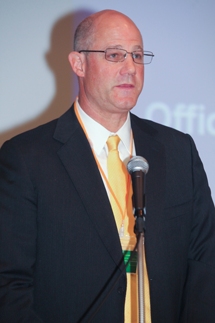
[Introduction]
- Based on the recognition that integrated examination of nuclear safety and security is increasingly important amidst escalating nuclear threats, and based on many years of experience, I would like to focus on the safety-security interface and its effective operation.
[The U.S. Nuclear Regulatory Commission's (USNRC) mission and regulatory framework]
- The USNRC has jurisdiction over the licensing of domestic civilian users of nuclear power and is responsible for protecting public health, safety, and the environment, and ensuring the protection of radiological materials.
- The regulatory framework, consisting of regulations, licensing, and oversight, must constantly undergo operational review to ensure its relevance and effectiveness.
[The U.S. approach to the security of nuclear reactors]
- The USNRC studies and analyzes information from intelligence agencies and other sources on a daily basis. Design basis threats (DBT) are assessed along with estimates of their scale. Facility operators take care not only to create detailed security plans including barriers, detection systems, access controls, and so forth, but also to incorporate deep layers of protection against insider threats and to prevent the breakdown of security functions that prevent inside information from reaching the hands of adversaries.
[Nuclear safety-security interface and regulatory framework]
- Since the 9/11 terrorist attacks, maintaining national security has become an important issue. In order to maintain effective nuclear security for nuclear reactors even under threat, the USNRC has worked to thoroughly review DBT, to link emergency situation management and nuclear security, and to upgrade training programs that incorporate nuclear security.
- Ineffective management of a nuclear safety-security interface will result in delays of scheduled activities, the generation of security vulnerabilities, and impacts on safety functions and emergency response activities. In that sense, an important point for effective nuclear security strategy is the ability to manage the nuclear safety-security interface. The USNRC established regulatory requirements for the safety-security interface in Title 10, Code of Federal Regulations, Part 73.58 (10 CFR 73.58) – Physical Protection of Plants and Materials. It specifies nuclear security for facilities. Guidance for this new requirement is published as USNRC Regulatory Guide 5.74, "Managing the Safety/Security Interface."
- The safety-security interface cannot be managed without effective transmission of information. I want to emphasize firmly the importance of information sharing at all levels across multiple sites. To give an example, operators and security personnel at power plants have different roles and responsibilities and their own organizational cultures. The nuclear safety-security interface requires independent initiatives to break down barriers put up by organizational cultures.
[Responses after the Fukushima nuclear accident]
- Following the Fukushima nuclear accident, a systematic, organizational review of the regulatory framework was carried out based on currently available information. A number of recommendations regarding protection against natural disasters, damage mitigation, and emergency response were issued. They are to be prioritized for implementation. No particular improvements to the oversight of nuclear security or the nuclear safety-security interface were identified as necessary.
- Regarding the Fukushima nuclear accident, even if long-term power outages or severe natural disasters occur, nuclear reactors and spent fuel pools must be maintained in a stable condition. Adversaries could take advantage of these compromised situations, therefore, appropriate countermeasures must be considered.
- Furthermore, some facility structures may be more vulnerable under an attack scenario, and could cause unexpected damage to core areas. Therefore, it is necessary to take both nuclear safety and security scenarios into account to protect buildings and other structures. Regarding emergency situation management procedures, constant improvement through comprehensive training based on lessons of actual events and elements of both safety and security is necessary.
[Conclusion]
- Nuclear safety and security are equally important. Maintaining their balance requires effective planning and coordination at all organizational levels. I hope you have learned through this presentation how the USNRC has improved the regulatory framework. I am certain that the United States is not the only country that is aware of the importance of the nuclear safety-security interface and is not the only State carrying out effective regulatory supervision.
Nuclear Safety and Security in the European Union
Dr. Didier HAAS, Adviser to the Director General, Joint Research Centre (JRC), European Commission
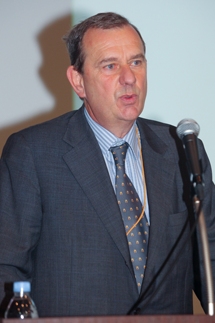
[The state of nuclear power in Europe]
- Fourteen of the 27 European Union (EU) Member States currently have nuclear reactors. Nuclear power accounts for 35 percent of Europe's power. Since the Fukushima nuclear accident, eight reactors have been shut down in Germany for purely political reasons. On the other hand, eight reactors are under construction in France, Finland, Slovakia, Bulgaria, and Romania, and construction of more than 24 reactors is planned. I am optimistic that in 2020, nuclear power will still account for the same percentage of power in Europe as it does today.
[Nuclear power plant stress tests]
- Reports on the results of the Member States' safety stress tests are to be submitted to the EC at the end of 2011. This will be followed by peer review. The EC will consolidate the Member States' reports and submit them to the European Council in June 2012.
- In addition to the 14 EU Member States that operate nuclear power plants, Lithuania, Ukraine, and Switzerland will participate in the peer review, and non-member States, including Japan, will participate as observers.
- The stress tests cover the results of nuclear accidents caused not only by earthquakes and tsunamis, but also by events such as bad weather and forests fires, and the consequences of loss of safety functions, such as loss of electrical power, loss of ultimate heat sink, or a combination of both. The stress tests will be implemented based on criteria defined by European Nuclear Safety Regulators' Group (ENSREG).
- While stress tests for nuclear safety target nuclear power plants and regulators, stress tests for nuclear security target countries. The goal is to analyze nuclear security and the prevention of and response to incidents due to malevolent or terrorist acts. The EC does not have a regulatory mission for nuclear security, but the progress report shows that EU Member States are committed to strengthening nuclear security systems. It emphasizes the nuclear safety-security interface and recommends working to share best practices in nuclear security culture and emergency situation management at the European and international levels. The final report on stress tests for nuclear security is due in June 2012.
[The Joint Research Centre's activities in the fields of safeguards and nuclear security]
- JRC carries out support activities regarding scientific and technical aspects of the fields of safeguards and nuclear security. These include activities related to support for traditional safeguards technology (development of non-destructive assay technology, etc.), support for the application of Additional Protocols (environmental sampling, etc.) detection of the illicit trafficking of nuclear material, as well as activities related to the provision of training.
- An initiative to establish centers (Centers of Excellence) to strengthen capacity to respond to threats from all weapons of mass destruction (chemical, biological, radiological, and nuclear weapons) began in 2010.
- In May 2011, training called STAR (STAte Response to terrorist attacks) was held in order to analyze national responses to terrorist attacks.
[Conclusion]
- Nuclear safety and security should be promoted in as integrated a form as is possible. Assessment of the risk of major accidents should be performed in terms of both safety and security during the construction of nuclear reactors.
- The EU and Japan have a strong relationship. Cooperation on safeguards, nuclear security, science and technology should be further strengthened in the future.
2012 Seoul Nuclear Security Summit
Mr. Choong-hee HAHN, 2012 Seoul Nuclear Security Summit Sous Sherpa, Ministry of Foreign Affairs and Trade, Republic of Korea
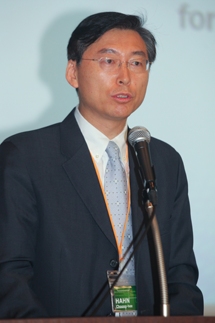
[Background and significance of the nuclear security summit]
- As background to the discussion of nuclear security, since 1993, more than 2,000 cases of the theft, loss, or illegal trafficking of nuclear or radiological materials have been reported to the IAEA. Thirty-three of the cases involved highly enriched uranium or plutonium. Since the 9/11 terrorist attacks, concern about nuclear terrorism in particular has been growing.
- In April 2009, President Obama gave a speech in Prague regarding a world without nuclear weapons. Regarding nuclear security, he committed to secure all vulnerable nuclear material within four years.
- Multilateral initiatives are necessary in order to promote nuclear security. Promotion of nuclear security is connected with promotion of the three pillars of the NPT, i.e., disarmament, nonproliferation, and peaceful uses of nuclear energy.
[The 2010 Washington Nuclear Security Summit]
- The Nuclear Security Summit held in Washington in April 2010 was attended by 47 nations, including three NPT non-member States, and three international organizations. Shared recognition of the threat of nuclear terrorism was obtained, and a communiqué was adopted. Individual countries indicated their commitment to return highly enriched uranium, establish training centers, and so on.
[The environment surrounding the 2012 Seoul Nuclear Security Summit]
- Current situations that should be considered as we approach the March 2012 Seoul Nuclear Security Summit include the security environment in a post–Osama bin Laden era, the "Arab Spring," the Fukushima nuclear accident, a nuclear renaissance, and a renewed awareness of the seriousness of the spread of radiological materials.
[The direction of the 2012 Seoul Nuclear Security Summit]
- At the Seoul Summit, progress since the Washington Summit will be reviewed and assessed. The principles and spirit of the Washington Summit will be reaffirmed. The Seoul Summit communiqué will move from political declaration to practical vision for implementation and highlight prioritized key objectives. In addition, I want to suggest that it will serve as a bridge for giving new vitality to policies on rebuilding peaceful uses of nuclear energy.
[Agenda and issues of the 2012 Seoul Nuclear Security Summit]
- The Summit's agenda may include the conversion of research reactors and reactors for the production of medical radioisotopes from highly enriched uranium to low enriched uranium and the IAEA's essential role as a focal point for nuclear security, international cooperation on illicit trafficking of nuclear material and border control, and information security. In nuclear security, respect for national sovereignty is necessary, yet international cooperation is also important. They must be simultaneously pursued.
- The interface between nuclear safety and nuclear security is important. It is necessary to address both elements from the design stage of nuclear facilities. It is also important to show that the concerns of the general public will be addressed and that both safety and security will be considered.
- In addition, I hope the summit will begin considering the security of radiological materials as well as nuclear material.
[Preparation for the 2012 Seoul Nuclear Security Summit]
- The Seoul Summit will be held on March 26 and 27, 2012. The Nuclear Industry Summit and Nuclear Security Experts Symposium are to be held the week before. Nuclear security requires contributions from all stakeholders, including industry and NGOs, as well as governments. The Republic of Korea will do its utmost to ensure the success of the 2012 Seoul Nuclear Security Summit under the slogan "Beyond Security Towards Peace." We hope to form a bridge between the voices and opinions of various countries and contribute to solving nuclear security problems.
Panel Discussion 1
"Nuclear security strategies and measures for civil nuclear facilities"
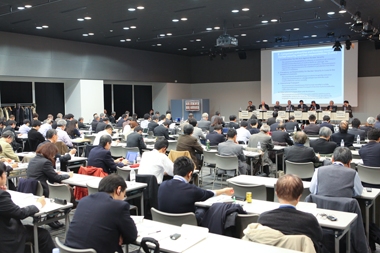
- Moderator
- Mr. Kaoru NAITO, President, Japan Nuclear Material Control Center (NMCC)
- Panelists
- Mr. Marc L. DAPAS, Deputy Director, Office of Nuclear Security and Incident Response, U.S. Nuclear Regulatory Commission (U.S. NRC)
- Mr. Denis FLORY, Deputy Director General and Head of Department of Nuclear Safety and Security, International Atomic Energy Agency (IAEA)
- Dr. Didier HASS, Adviser to the Director General, Joint Research Centre (JRC), European Commission
- Mr. Choong-hee HAHN, 2012 Seoul Nuclear Security Summit Sous Sherpa, Ministry of Foreign Affairs and Trade, Republic of Korea
- Mr. Toshiro MOCHIJI, Director, JAEA/STNM
- Prof. Yoshihiro NAKAGOME, President, Japan Nuclear Energy Safety Organization (JNES) / Emeritus Professor, Kyoto University
- Prof. Mitsuru UESAKA, Professor, Nuclear Professional School, School of Engineering, The University of Tokyo
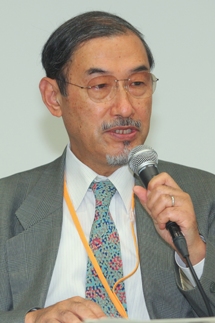 Mr. Kaoru NAITO
Mr. Kaoru NAITOPurpose:
To discuss measures on nuclear security at nuclear facilities in terms of "Basic Policies and Principles for Ensuring Nuclear Security" based on the IAEA Fundamentals and Recommendations, nuclear security risks that might cause a major accident, considering the lessons learned from the Fukushima accident, and the roles and responsibilities of states and facility operators in nuclear security, etc.
Discussion points:
- Domestic adaptation of the IAEA Nuclear Security Guidelines Series, Nuclear Security Fundamentals and three Recommendations documents
- Possible challenges in realizing "Basic Policies and Principles for Ensuring Nuclear Security" produced in response to IAEA nuclear security basic documents
- Nuclear security challenges and lessons learned from the Fukushima nuclear accident and nuclear security issues to be resolved
- Vulnerabilities in nuclear security recognized from the accident
- Assuring nuclear security measures in radiological emergency and for insider threats
- Nuclear security strategies and measures for nuclear facilities
- Assessment of nuclear security risks resulting in severe accidents
- Roles and responsibilities of the regulatory authorities and facility operators in response to nuclear security events
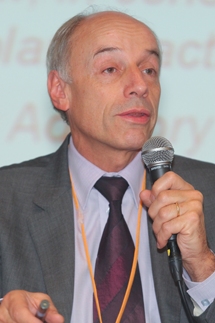 Mr. Denis FLORY
Mr. Denis FLORYDiscussion Point 1: Domestic adaptation of the IAEA Nuclear Security Guidelines Series, Nuclear Security Fundamentals, and three Recommendation documents
- The background, history, and an overview of the IAEA's Nuclear Security Series, Fundamentals, three Recommendations1, implementation guidelines, and technical manuals were introduced. In light of the importance of balancing nuclear safety and nuclear security, IAEA advisors recommended that all nuclear safety and security documents be coordinated to ensure a consistent safety and security interface.
- The advisory committee on nuclear security under the Japanese Atomic Energy Commission produced the "Fundamental Approach to Ensuring Nuclear Security" in response to the IAEA's Nuclear Security Fundamentals. It points out the necessity of ensuring the proper independence of regulatory and administrative agencies and of integrating and coordinating related agencies.
How to foster nuclear security culture? Harmonization of medical and industrial use of radiation sources with nuclear security requirements such as access control
- Fostering a nuclear security culture requires cooperation not only from each worker but also a firm commitment at the top level of management. A nuclear security culture must be incorporated into the very nature of the organization. Recognizing that education, training, and outreach are all important, the IAEA launched the International Security Education Network (INSEN) to promote these activities.
- Researchers and students have considered their research to be important, but did not always understand the necessity of participating in safety culture. Over time, however, the idea has spread. Also, nuclear security culture was considered to be the sole job of the police. In order to correct this, safety culture and nuclear security culture should be disseminated and practiced together without confusing separate safety or security objectives.
- From Professor Uesaka's point of view, education related to nuclear security culture is just beginning at universities. He encouraged textbook production, visits from agencies involved in nuclear power and making effective use of the IAEA's INSEN. Students could also gain knowledge of nuclear security culture and regulations by performing research at actual nuclear facilities.
- The USNRC has set forth regulatory requirements for the safety-security interface and published updated guidance. The USNRC also issued the Safety Culture Policy Statement, which states that safety and security are equally important. However, because the individual cultures of each organization form barriers, effective coordination and communication within and between organizations is vital.
1Nuclear Security Recommendations on Physical Protection of Nuclear Material and Nuclear Facilities (INFCIRC/225/Rev.5), Nuclear Security Recommendations on Radioactive Material and Associated Facilities, and Nuclear Security Recommendations on Nuclear and Other Radioactive Material out of Regulatory Control
Discussion Point 2: Nuclear security challenges and lessons learned from the Fukushima nuclear accident and nuclear security issues to be resolved
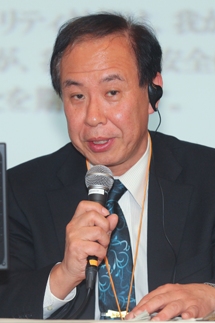 Mr. Toshiro MOCHIJI
Mr. Toshiro MOCHIJILessons learned from the Fukushima nuclear accident
- Japan is currently working towards settlement of the Fukushima nuclear accident. All information on this is available to the public, including detailed information on vulnerabilities. In Japan, it seems the differences between safety and security are not clear, and information has likely been disclosed with an emphasis on transparency from a safety perspective. Since the accident, the Ministry of Economy, Trade and Industry has been discussing implementation of additional physical protection measures, but has not disclosed the contents of the discussions.
- Following the 9/11 terrorist attacks in 2001, the NRC issued a regulation called B.5.b that requires the implementation of new strategies, which may include installation of new equipment, to mitigate the beyond design basis loss of a large area of a reactor plant due to fires, the impact of aircraft crashes, etc. Since the Fukushima nuclear accident, USNRC has asked licensees to check whether the new equipment they installed under B.5.b would function properly in the event of a natural disaster.
- In the EU, national regulators are conducting stress tests on nuclear reactors to confirm safety functions. Checks of facilities' nuclear security vulnerabilities are not included in this assessment. The results of the safety stress tests will lead to revisions of regulations in some countries. At the EC level as well, the EC is discussing revision of its directives. Regarding nuclear security, a survey has been taken concerning individual countries' regulations on nuclear security, nuclear security culture, DBT, emergency situation management plans, etc. Guidelines for severe accidents differ by country. For example, Germany has performed stress tests covering aircraft impacts.
- The focus of the Washington Nuclear Security Summit, was on the management of plutonium and highly enriched uranium; however, the Fukushima nuclear accident highlighted the necessity of including the category of radiological materials in consideration of protection of nuclear facilities and measures to counter terrorism. In particular, the importance of measures against sabotage of nuclear facilities has increased. Entry into force of the amended Convention on the Physical Protection of Nuclear Material, which spotlights protection of nuclear facilities, and the incorporation of the Nuclear Security Recommendations on Physical Protection of Nuclear Material and Nuclear Facilities (INFCIRC/225/Rev.5) into national regulations are therefore important steps to be taken.
- Some aspects of the transparency and openness emphasized in nuclear safety can conflict with the secrecy and opacity emphasized in nuclear security. In addition, more stakeholders are involved with nuclear security than with nuclear safety, making it comprehensive and extremely complex. Balancing nuclear safety and security is very important, and care must be taken to ensure that they do not interfere with each other.
- In light of the Fukushima nuclear accident, South Korea established a Nuclear Safety and Security Commission as a new, more independent regulatory agency under the president. It has jurisdiction over and supervises nuclear safety, nuclear security, and safeguards.
Maintaining nuclear security function at the time of radiological emergency, the actual system for checking "trustworthiness" of workers in the US, EU and ROK, and Japan's effort to cope with internal threats
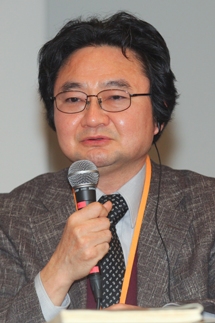 Prof. Mitsuru UESAKA
Prof. Mitsuru UESAKA- In Japan, INFCIRC/225/Rev.5 is being incorporated into domestic regulations. Progress is being made on defining the Nuclear Safety Agency that will be established in 2012 and on consideration of a security clearance system for people with access to special state secrets. Insider threats are a very difficult problem. Japan must consider how to respond in light of the fact that civilians are not allowed to carry weapons.
Measures to prevent intrusion by suspicious persons during emergencies and security clearances
- Intrusion by suspicious persons during emergencies is different from acts of terror that are planned long before being carried out, but must also be considered. When security degrades, as in a prolonged blackout, supplemental measures such as posting more security guards or bringing in outside personnel might be necessary.
- In the EU, when a facility operator cannot respond for some reason, armed police will respond. Moreover, strict individual security clearances are required not just for operators, but also for maintenance personnel and contractors.
- In South Korea, as more nuclear reactors are installed, more work is required to protect nuclear material. Full-time employees are screened for criminal records. Employees work in groups of two to three people, work is supervised, and biometrics is used to control access to important areas. Furthermore, education and training hours for nuclear power plant employees are specified by regulation. An education and training support center is to be established during 2013. Japanese, Chinese, and Korean support centers should coordinate and cooperate on raising awareness of nuclear security and fostering nuclear security culture.
- In France, there was a case in which a disgruntled employee intentionally tripped a nuclear reactor. In light of this, the French Institute for Radiological Protection and Nuclear Safety (IRSN) has implemented drug and alcohol testing similar to that of civil airlines. This is a necessary step along with behavioral observation.
- In the United States, measures against insider threats follow a strict process. When an individual joins a facility, there is a screening process that includes a five-year work history, criminal background check, fingerprinting, and PAD system check (a database with records of any adverse acts performed on the job). In addition, employee behavioral observation programs and education are carried out. Personnel are encouraged to report any unusual behavior by their colleagues.
- When natural disasters occur, first responders such as fire and rescue personnel are dispatched. Consideration should be given regarding security clearances for these personnel and what aspects of safety and security are necessary for them to know.
- Presently, in Japan it is considered difficult to implement a security clearance system due to concerns about the protection of personal information. On the other hand, employee attitudes are monitored, which may be an effective means of handling insider threats.
Questions from the floor
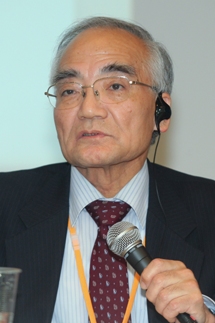 Prof. Yoshihiro NAKAGOME
Prof. Yoshihiro NAKAGOME- Question 1: Is the IAEA considering training that covers terrorist attacks like the EU's STAR does?
>> Answer 1: The IAEA provides an International Physical Protection Advisory Service (IPPAS), which surveys Member States' nuclear material protection levels and provides necessary recommendations. In addition, the Incident and Emergency Center (IEC) serves as a go-between and coordinates emergency situation management among countries in the event of a nuclear accident. That scenario could be used in training. There would be problems with handling sensitive information, but I (IAEA DDG Flory) would like to carry out training in cooperation with the EC. - Question 2: Do you think it is necessary for Japan to perform stress tests on nuclear security?
>> Answer 2: They should be performed if needed. If, for example, stress tests regarding the collision of aircraft with nuclear reactors are considered necessary, they should be performed. - Question 3: What systems should be subjected to stress tests for nuclear security?
>> Answer 3: One answer would be that in the United States after the 9/11 terrorist attacks in 2001, regulation (B.5.b) was issued requiring facility operators to install new equipment that can withstand aircraft impacts and fires.
Discussion Point 3: Nuclear security strategies and measures for nuclear facilities
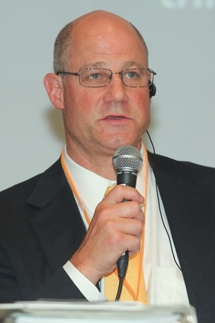 Mr. Marc L. DAPAS
Mr. Marc L. DAPASAssessment of nuclear security risks resulting in severe accidents
- Nuclear security vulnerability and performance assessment methodology in the United States
- Since the 9/11 terrorist attacks, comprehensive assessments and impact assessments considering airborne, ground, and water attacks have been performed for all U.S. nuclear reactors. For those found particularly vulnerable, assessments have been performed using concrete threat characteristics and modes of attack. It is important to clearly distinguish between an attack that the facility operator should respond to and one made by a national adversary that the State should respond to.
- Under the B.5.b regulation, the possible responses of facility operators to threats beyond design basis are assessed. Vulnerability assessments are used to judge whether facility operators can realistically provide a higher degree of protection for these scenarios.
- Force-on-force training is carried out at each U.S. nuclear power plant every three years. These training drills must be carefully planned and executed because should they fail, public confidence in nuclear power could be weakened. This example highlights the difficulty of balancing the need to be transparent with the public in order to build trust in the operation and regulation of nuclear power plants and the handling of emergency situations with the need to protect some information to ensure continued security of operations.
- Nuclear security vulnerability and performance assessment methodology in the EU
- Member States in the EU carry out threat assessment and scenario research, 3S integration from the design stage, detection of nuclear material theft, and the European Community Urgent Radiological Information Exchange (ECURIE). In addition, the EU Security Training Center performs training using actual nuclear material.
- Nuclear security strategies applied to nuclear power plants and safeguards implementations depend on the use of similar tools. Many technologies, such as radiation monitors, surveillance systems, and nuclear forensics are applicable to both nuclear security and safeguards and it might be possible to share some of these tools at the same facility. For greater efficiency and effectiveness, it is necessary to integrate safeguards and security measures as early as possible in the design stage of the facility.
The current state of and future outlook for risk assessment in nuclear security and issues with performance assessment of nuclear security at nuclear power plants
- It can be difficult for some countries to develop design basis threats by themselves. The IAEA cannot develop DBTs for individual countries, but it provides support by holding workshops on development methods.
- In risk assessments, the threat of nuclear terrorism is still possible, and terrorists are not the only ones who could perform malicious acts. For example, smuggling groups act intentionally based on financial motivations. Thus, risk factors should be considered broadly. On this point, the Convention on the Physical Protection of Nuclear Material includes clauses on criminal penalties, which serve as a deterrent. Fortunately, nuclear terrorism and sabotage have yet to occur; however, that is partly responsible for a lack of shared threat awareness. It will be necessary to address this at the 2012 Seoul Nuclear Security Summit.
- In the United States, hundreds of millions of dollars have already been invested in security at nuclear facilities. The question of how much security is needed is often raised to balance the cost of additional nuclear security and its added effectiveness. In an ever-changing environment, the regulatory side has to frequently review the threats, costs of measures, and decide which measures are appropriate and rational.
- The conflict between safety and security during emergencies has not gone away. The USNRC not only promotes understanding of the concept of the safety-security interface, it carries out training that covers emergency situations in order to balance the two. From this perspective, facility operators are required by law to perform periodic force-on-force training. One expert's opinion is that because force-on-force training is so visible, its success can become the objective, and it may fail in its role of uncovering issues. How much information to disclose about force-on-force training is also an issue.
Roles and responsibilities of national governments and facility operators in response to nuclear security
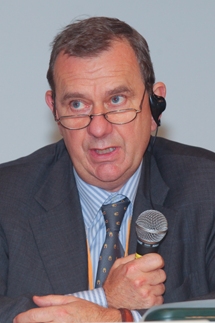 Dr. Didier HASS
Dr. Didier HASS- The case of Japan:
- In Japan, when concerns related to nuclear security arise, there is a specified process for the relevant agencies and organizations to follow. However, simply establishing a system is not in itself sufficient. It is essential to utilize additional training to check whether the system functions properly. Moreover, results of vulnerability assessments should be shared among the relevant agencies.
- Security at research reactors and medical isotope facilities is weak compared with that of nuclear reactors for power generation. At university research reactors, priorities for safety and security in emergencies have not been decided. Universities take the position of emphasizing safety, but they cooperate with the decisions of security authorities. To researchers, it is important in terms of research performance to announce and publish research and development results, but from the perspective of nuclear security, complete openness is undesirable. Standards and basic guidelines on announcing and publishing research results should be set. Regulations that are too strict may hinder the development of science and technology, and there are budgetary difficulties as well. Japan must make a firm decision on how to handle this.
- In Japan, it seems that there is no control tower for crisis management. There is control in the event of natural disasters, but what about nuclear disasters? Additionally, data related to vulnerability assessments must be shared among relevant agencies.
Questions from the floor
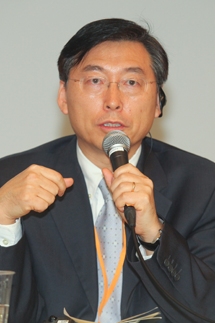 Mr. Choong-hee HAHN
Mr. Choong-hee HAHN- Question 1: US force-on-force training is important for raising the level of nuclear security. Do you ever perform simulations for reasons such as costs? And, is the force-on-force training disclosed to the public?
>> Answer 1: Simulations would be difficult because there are so many elements involved. However, tabletop preparations can be made. The training is not disclosed to the public, but reports are published with sensitive information removed. - Question 2: I think that in the "Response Flow in Event of Security Incident" flowchart, deciding whether it is a "severe security incident or not" depends on the type and amount of nuclear material. Are there standards for judging whether the type and amount of nuclear material is "severe" or not?
>> Answer 2: I think that, for example, it would be covered by the Act on Special Measures Concerning Nuclear Emergency Preparedness, which refers to a nuclear disaster prevention manager reporting "detection of radiation in an amount exceeding standards set by government ordinance."
Moderator's Summary of the Panel Discussion 1:
"Nuclear security strategies and measures for civil nuclear facilities"
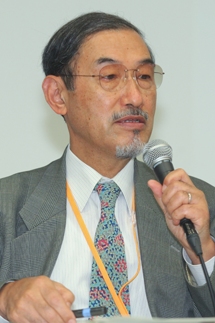
Through the presentations and the discussions by the panelists, the following key points were raised in the Panel Discussion 1:
1. Under the Discussion Point 1 "Domestic adaptation of the IAEA Nuclear Security Guidelines Series, Nuclear Security Fundamentals and three Recommendation documents"
- In order to establish security culture, it is not enough to involve individual workers alone but also to make the top management committed and to embed the security culture in the organization itself. The experience of fostering safety culture may be useful in establishing security culture. In this context, education and outreach activities are important and the IAEA has launched INSEN (International Security Education Network) for this purpose. As a regulatory body, the USNRC has published "Safety Culture Policy Statement", a single policy statement that covers both safety culture and security culture, emphasizing that safety and security are equally important;
- For radioactive materials, a graded approach should be adopted in order to harmonize the use of radiation with nuclear security requirements such as access control.
2. Under the Discussion Point 2 "Nuclear security challenges and lessons learned from the Fukushima nuclear accident"
- In view of the Fukushima accident, U.S. licensees were asked to review whether a natural disaster would disable the function of additional equipment that has been prepared to meet the B.5.b requirement formulated by the USNRC after the 9/11 terrorist attacks;
- The EU stress tests conducted in view of the Fukushima accident contains a nuclear security track that does not cover the vulnerability check of an individual plant in a State but requires the general description of a State's legal framework for nuclear security, nuclear security culture in that State, emergency preparedness and so forth;
- After the Fukushima accident, the main focus of global nuclear security has shifted to include the protection of radioactive materials and nuclear facilities as well as the protection of nuclear materials;
- Under a prolonged total station blackout, more security guards should be posted in order to counter the nuclear security threat;
- In EU countries, the United States and Korea, the trustworthiness check of an employee has been an established practice for nuclear facilities and is based on dedicated laws for that purpose;
- Monitoring staff behavior is also an effective measure to counter internal threats.
3. Under the Discussion Point 3 "Nuclear security strategies and measures for nuclear facilities"
- From the operators' point of view, the question "How secure is secure enough" is often raised to balance the cost of additional nuclear security and its added effectiveness;
- Force-on-force drills are carefully planned to minimize the risk of failure, because should they fail, the potential for negative publicity and loss of public confidence is great.
- The conflicts between safety and security has not yet been resolved for emergency situations;
- While researchers are required to publish R&D results for the sake of research performance, it is not always possible to publish the results of R&D in the field of nuclear security. The basic policy for disclosing such results should be established;
- Information sharing with international partners without disclosing specific vulnerabilities is felt to be important;
- It is not enough to establish a coordination scheme in the case of a nuclear security event, but its effectiveness should be proven through emergency exercises.
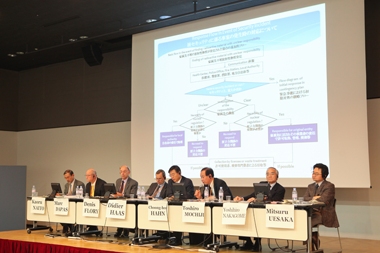
Panel Discussion 2
"An Integrated Approaches to Nuclear Safety and Nuclear Security"
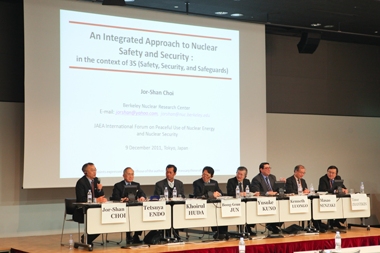
- Moderator
- Dr. Jor-Shan CHOI, Associate Director of Berkeley Nuclear Research Center (BNRC) at the University of California at Berkeley, United States of America
- Panelists
- Ambassador Tetsuya ENDO, Chair of the Taskforce, the Japan Institute of International Affairs (JIIA)
- Dr. Khoirul HUDA, Deputy Chairman for Nuclear Safety Assessment, Nuclear Energy Regulatory Agency (BAPETEN), Republic of Indonesia
- Prof. Bong-Geun JUN, Institute of Foreign Affairs and National Security, Ministry of Foreign Affairs and Trade, Republic of Korea
- Dr. Yusuke KUNO, Professor (appointed), Nuclear Non-Proliferation Research Laboratory, Department of Nuclear Engineering and Management, School of Engineering, The University of Tokyo / Deputy Director, JAEA/STNM
- Mr. Kenneth N. LUONGO, President of the Partnership for Global Security
- Mr. Masao SENZAKI, Director, Integrated Support Center for Nuclear Non-proliferation and Nuclear Security, JAEA
- Dr. Timur ZHANTIKIN, Chairman of the Atomic Energy Committee, Ministry of Industry and New Technologies of the Republic of Kazakhstan
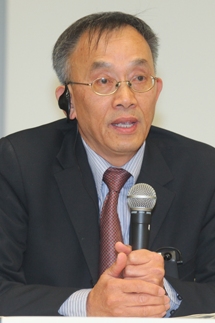 Dr. Jor-Shan CHOI
Dr. Jor-Shan CHOIPurpose:
- Discuss the importance of 3S (safety, security, and safeguards (nonproliferation)) initiatives Discuss the 2S (safety/security and security/nuclear nonproliferation (including safeguards and quantitative control)) interfaces and synergistic effects
- Summarize the discussions in a message to the 2012 Seoul Nuclear Security Summit.
Discussion points:
- Interface and synergistic effects between nuclear safety and nuclear security, and nuclear security and safeguards (nonproliferation)
- 3S synergy for emerging nuclear energy countries – Regional (multilateral) approach for safeguards
- Review of 2010 Nuclear Security Summit in Washington D.C., follow-up activities of each State and message to 2012 Seoul Nuclear Security Summit
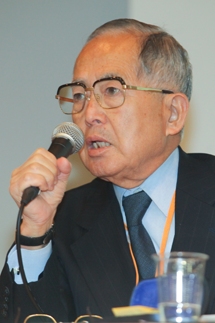 Ambassador Tetsuya ENDO
Ambassador Tetsuya ENDODiscussion Point 1: Interface and synergistic effects between nuclear safety and security, and nuclear security and safeguards (nonproliferation)
Prior to the panel discussion, Dr. Choi, the panel moderator, explained the issues and challenges related to the 3S (safety, security, and safeguards) initiative and the 2S (safety/security and security/safeguards) initiatives by using the following chart. The Japanese government advocated the 3S initiative at the 2008 Toyako Summit, while the 2S initiative of security and safeguards was discussed at the 2010 Washington Nuclear Security Summit. The 2S initiative of nuclear safety and security is expected to be discussed at the 2012 Seoul Nuclear Security Summit.
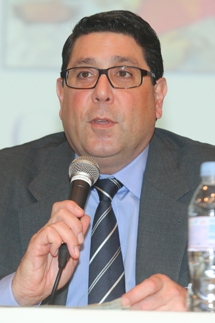 Mr. Kenneth N. LUONGO
Mr. Kenneth N. LUONGO- Each element of 3S has its own individual objectives as follows;
- Safety: preventing accidents
- Security: preventing sabotage and theft at nuclear facilities
- Safeguards: preventing conversion of nuclear material to nuclear weapons
- In terms of the 2S of nuclear safety and security, the Fukushima nuclear accident exposed the fact that conventional nuclear governance is not sufficient. In order to prevent terrorism's misuse of fissile or radiological material or the release of radiological material from nuclear reactors, the international community must come together in order to confront various issues in nuclear safety and security. For this purpose, nuclear safety regulatory methods, which have many years of experience, could support the development of nuclear security measures. The entire international community is expected to form a consensus on this 2S initiative of nuclear safety and security at the 2012 Seoul Nuclear Security Summit.
3S initiative:
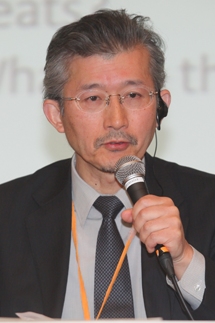 Dr. Yusuke KUNO
Dr. Yusuke KUNO- Discussion of the 3S initiative has not evolved since the 2008 Toyako Summit. Originally, the 3S norms were proposed as prioritized areas for supporting emerging nuclear energy countries, but they have also been criticized as additional conditions that are burdensome for such countries to implement; however, since the Fukushima accident, interest in 3S has been renewed.
- Effective integration of 3S should be implemented in all emerging nuclear energy countries. IAEA should take a more active role in strengthening safety and security practices and standards, providing training, and acting as the focal point for international nuclear cooperation and exchange of best practices in order to increase the global nuclear safety and security levels to maximize economic prosperity and well-being.
2S interface and synergistic effects between nuclear safety and security:
- Fukushima provided the example of an accident-caused degraded situation that could become vulnerable to terrorism or sabotage. One area is spent fuel security. Cyber-attacks are also vulnerabilities and could result from insufficient integration of information handling practices for safety and security. Although the characteristics of safety and security are different, some consequences, such as loss of power or trained personnel might be the same for both accident and sabotage.
- Transparency through disclosure of information is emphasized in nuclear safety, while effective nuclear security requires confidentiality of sensitive nuclear information. It is necessary to work out a suitable interface between these two conflicting requirements. However, increased transparency does not necessarily mean making sensitive information public. In one example, the United States and Russia have found ways to work together to improve nuclear security without compromising sensitive information.
- It is also important that regulators of these two areas share information. In Indonesia, a single organization comprehensively oversees and manages both nuclear safety and security issues.
2S interface and synergistic effects between nuclear security and nuclear nonproliferation (safeguards):
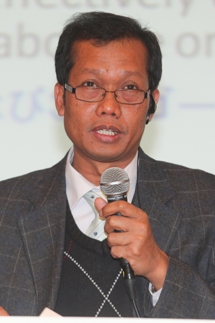 Dr. Khoirul HUDA
Dr. Khoirul HUDA- The government is responsible for applying safeguards to nuclear facilities, while it is the operator's responsibility to provide nuclear security measures for the facility. However, both security and safeguards require strict confidentiality, and they both have the responsibility to prevent nuclear proliferation.
- Nuclear forensics is a useful technology for both nuclear security and safeguards. In light of cost effectiveness, there is no need to have duplicate laboratories.
What are the goals for 2S and 3S?
- Each element of the 3S shares a common goal of protecting human beings and the environment from nuclear hazards. It is important to integrate or coordinate each element of the 3S when promoting this 3S initiative. However, each "S" has developed differently in different countries. In this regard, national sovereignty of each State, together with its political situation and the use of nuclear energy, should be fully respected, when promoting the 3S initiative.
- Both the Nuclear Security Summit series and the Fukushima accident have highlighted the fact that there is no international security governance system. Today's security systems are nationally focused and voluntary, and insufficient for protecting the global community. A formal framework is needed. Some panelists advocated having two paths to achieve this; a formal amendment process, which can take many years to implement, and an informal consensus building effort that could be implemented relatively quickly and could be addressed through a coalition of countries that are regional or have special interests. Further exploration and balancing of additional binding and non-binding international safety and security requirements should be done.
- The nuclear security regime is 20 years behind that of nuclear safety. In this context, international consensus is urgently required and various methods, including international, regional, governmental, NGO and academic approaches, should be explored as paths to achieve consensus on establishing international norms on nuclear security.
3S initiatives for emerging nuclear energy countries
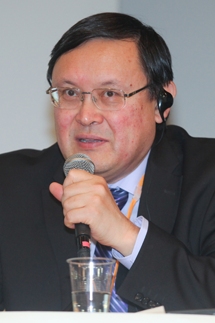 Dr. Timur ZHANTIKIN
Dr. Timur ZHANTIKIN- Based on an IAEA report on multilateral approaches to the nuclear fuel cycle (MNA, INFCIRC/640), a team from The University of Tokyo proposed an economical, sustainable and feasible MNA framework to ensure nuclear fuel cycle services, which included fuel supply assurance, spent fuel management and MOX fuel storage, together with 3S.
- Emerging nuclear energy countries need to establish a 3S-based nuclear energy infrastructure, which includes human resource development, education and training. In this context, both international and regional cooperation is important and the IAEA is expected to play a leading role in this area.
How to encourage appropriate safety and security standards, to ensure the proper degree of independence of regulatory agencies, and to vigorously implement performance-based safety and security measures for emerging nuclear energy countries?
- The following measures would be worth considering;
- Creation of international standards by the IAEA and providing necessary support for emerging nuclear energy countries
- Sharing good and best practices
- Information exchange
- Utilization of existing regional safeguards networks, such as the Asia-Pacific Safeguards Network (APSN)
- In addition, the Middle East could be a test case for international management of nuclear facilities incorporating synergistic effects of 3S, especially that of the 2S of safeguards and nuclear security. Nuclear supplier States should consider this 3S-or 2S-based assistance when supplying their nuclear reactors to emerging nuclear energy countries.
How should the international community promote the 3S approach in an integrated way? What is the effective and efficient cooperative regime between developed countries and emerging nuclear energy countries to strengthen 3S?
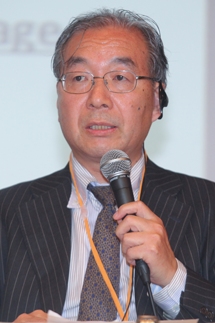 Mr. Masao SENZAKI
Mr. Masao SENZAKI- In Kazakhstan, Russian-origin highly enriched uranium (HEU, used research reactor fuel) has been removed from Kazakhstan under the U.S. Global Threat Reduction Initiative (GTRI). Furthermore, various nuclear safety and nuclear security projects, including strengthening nuclear safety and security measures at nuclear facilities, have been underway under the U.S.-Kazakhstan cooperation regime. Both Japan and Kazakhstan had worked together to improve nuclear material accounting and physical protection of nuclear materials in Kazakhstan. Emerging nuclear energy countries need adequate support and assistance from nuclear developed States.
- Another useful method for promoting nuclear security measures would be to establish nuclear security systems based on existing nuclear safety regulatory systems. Cooperative management of both nuclear safety and security could mitigate various conflicts on information transparency vs. secrecy and State vs. industry leadership.
- In order to establish an effective 3S-based system, it is necessary to comprehensively incorporate the 3S concept into nuclear facility design. For this purpose, every organization with responsibility for 3S should be required to collaborate and coordinate with each other as well as to share necessary information and experience.
Discussion Point 2: Review of the April 2010 Washington Nuclear Security Summit's discussion points and results, follow-up activities of each State, and message to the 2012 Seoul Nuclear Security Summit
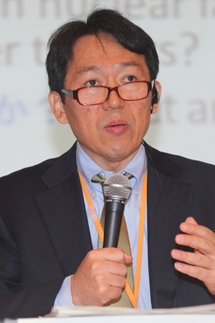 Prof. Bong-Geun JUN
Prof. Bong-Geun JUN- The purpose of the 2010 Washington Nuclear Security Summit was to enhance international cooperation to prevent nuclear terrorism, which was identified by President Obama as the most immediate and extreme threat to global security. The goals of the Summit were:
- to come to a common understanding of the threat posed by nuclear terrorism
- to agree to effective measures to secure nuclear material, and
- to prevent nuclear smuggling and terrorism.
- The Summit focused on the security of nuclear materials. In this context, a communiqué aiming to establish an international system for managing nuclear material for preventing nuclear terrorism, as well as a work plan to be voluntarily carried out by each nation to support the communiqué were adopted.
- Since the 2010 Washington Nuclear Security Summit, Japan took various nuclear security related actions including;
- The Japan Atomic Energy Commission's "Basic Policies and Principles for Ensuring Nuclear Security" was a domestic adoption of the IAEA Nuclear Security Guidelines series' fundamentals and recommendation documents
- Establishment of the Integrated Support Center for Nuclear Non-proliferation and Nuclear Security (ISCN)
- Development of technology related to measurement and detection of nuclear material and nuclear forensics under the U.S.-Japan cooperation agreement
- Contributions to the IAEA nuclear security programs
- Kazakhstan, China and ROK also have plans to establish support centers for human resources development in nuclear security.
- Nuclear security is a basis for all three pillars of the NPT (disarmament, nonproliferation, peaceful use of nuclear energy). At the 2012 Seoul Nuclear Security Summit, as is the case with the Washington Summit, nuclear security will be the main issue. However, the synergy and interface between nuclear security and nuclear safety will be a new topic for discussion. A nuclear security symposium, together with a nuclear industry summit, will be also held as side events to the Summit. With the participation of international organizations, regulatory agencies and NGOs, various challenges and solutions in nuclear security and the interface with nuclear safety will be discussed during the symposium.
- Even after the 2012 Seoul Nuclear Security Summit, momentum on further improvement of nuclear safety and security must be maintained and sustained. In this context, sharing of best practices by civilian nuclear facility operators and promotion of interaction among all stakeholders, such as regulatory agencies, nuclear facility operators, international organizations, and experts, should continue to be implemented.
Questions from the floor
- Question 1: How should the 3S initiative be applied to spent fuel storage?
>> Answer 1: As the Fukushima accident made clear, ensuring nonproliferation and security of spent fuel storage pools and molten fuel requires some sort of international cooperation. Transnational collaboration and coordination under the IAEA's leadership is essential. - Question 2: How can regulatory authorities concretely improve 3S as a means of gaining public trust?
>> Answer 2: It is necessary for regulatory authorities and nuclear facility operators to hold dialogs and exchange opinions. It is also important to provide the mass media and the general public with accurate and appropriate information.
Moderator's Summary of the Panel Discussion 2:
"An integrated approach to nuclear safety and nuclear security"
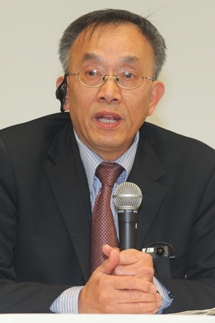
- An international initiative on 3S- (safety, security, and safeguards) based nuclear energy infrastructure was first proposed by Japan in the G8 Summit 2008 at Chitose, Hokkaido, Japan.
- There is synergism between security and safeguards when the threats focus on the nuclear material, and the outcome (either terrorists acquiring or a host State diverting nuclear material) has weapons consequence. There is also synergism between security and safety when the threats involve nuclear facilities, and the results (accidents caused by system failure, human error, natural disaster, or by sabotage, malicious acts, etc.) have radiological consequence. However, there are distinct differences among the 3S due mainly to their different legal instruments.
- The 3S should be adopted by all countries engaging in peaceful use of nuclear energy. The developed countries should provide cooperation and support on 3S to newcomer countries introducing nuclear power. The 3S would be best implemented at the early stage of nuclear power development and should be pursued with strong leadership. The multi-national approaches (MNA) may be a very effective means of implementing 3S in nuclear fuel cycle related activities. The IAEA should also take an active role in the integration of 3S.
- The largely voluntary nature of and national approaches to the implementation of nuclear security and safety are in conflict with the fact that nuclear crises do not respect borders, as noted by the UN Secretary General. The lack of information transparency and policy consensus in nuclear security also makes harmonization of the safety and security regimes difficult. Nuclear security must overcome these barriers (sovereignty, transparency, consensus, and regime harmonization) for the effective application of elements of the safety regime into the nuclear security regime.
- Increased transparency does not mean making sensitive information public; the United States and Russia have found ways to work together in improving nuclear security without compromising sensitive information. Also, IAEA safeguards and inspection practices in a Member State remain confidential.
- The Fukushima accident on March 11, 2011, presented the second Nuclear Security Summit in Seoul, Korea in 2012, an opportunity to expand its scope to include nuclear safety. However, adopting nuclear safety in the Seoul Summit also presented a few challenges, e.g.:
- It might be overwhelmed by nuclear safety.
- It might get into the endless debate on whether a military action of one country against nuclear facilities of another country constitutes as a malicious act.
- A country's rights to control its nuclear materials and facilities must be better balanced with its responsibilities to protect the international community from nuclear crises. Hence, the safety and security of nuclear materials and facilities have significant transnational implications and must be incorporated in the consideration of long-term global nuclear governance. We should heed the advice from IAEA DDG Flory that "a two-track approach: launching a carefully planned amendment process, and supplemented by a variety of mechanisms and non-binding tools available to the international community is the right way forward to respond to the need for urgent actions to strengthen nuclear safety (and nuclear security), without foregoing the longer term, more potent tools of a strengthened international legal regime"
- Integration of 3S could enhance the regulatory framework and improve public confidence in nuclear power when each State demonstrates its commitment to effective cooperation and coordination across responsible domestic and international agencies and promotes dialogue and openness with the public as an key stakeholder.
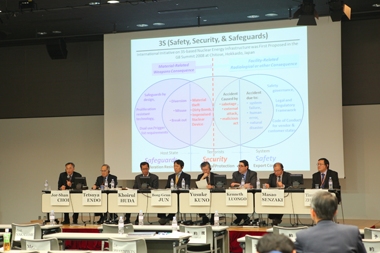
Closing Remarks
Prof. Hiroyuki TAKAHASHI, Professor, Graduate School of Engineering, The University of Tokyo
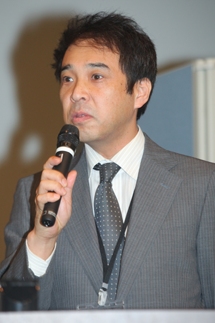
- I greet you as a representative of The University of Tokyo's Global Center of Excellence (G-COE) Program.
- My five years with The University of Tokyo's G-COE Program is about to end. The project has discussed many subjects, including nuclear safety and security. I will continue to support this kind of international activity. I hope it will lead to improvements in nuclear engineering.
Ambassador Tetsuya ENDO, Senior Fellow, the Japan Institute of International Affairs (JIIA)
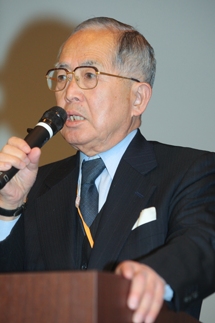
- I am gratified by the lively discussions that have developed at this forum on nuclear safety and security, the importance of which has been reemphasized by the Fukushima nuclear accident.
- It is necessary to be more concerned than ever before with nuclear security. I am optimistic about the 2012 Seoul Nuclear Security Summit as well.

